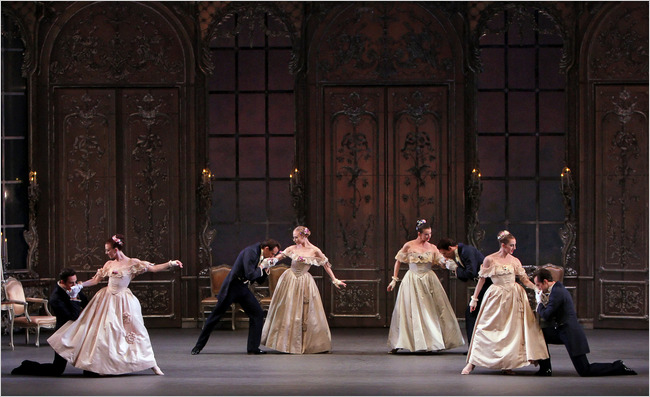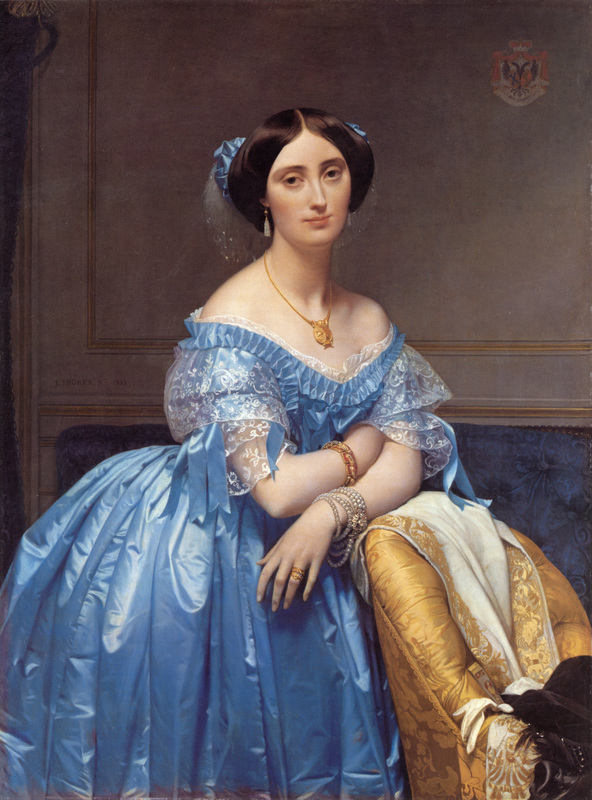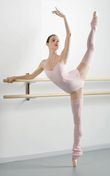Liebeslieder, choreographed to Johannes Brahms’s Liebeslieder Walzer Op. 52 and Neue Liebeslieder Walzer Op. 65 for four voices and four hands at the piano, is an outlier in Balanchine’s canon. Most of his ballets are set to fuller orchestral scores. And except for some short vocal sections in Mendelsohn’s Midsummer Night’s Dream and the children’s chorus in the snow section of Tchaikovsky’s Nutcracker, there are no others in which we get to dance Balanchine’s steps to the sound of the human voice. The mis-en-scène is also atypical for Balanchine, who often preferred
Four couples stand poised to begin waltzing attired in costumes also atypical for Balanchine, who in many of his most iconic ballets stripped costumes down to mere leotards and unadorned practice clothes. The men wear evening dress in midnight blue, with tails, ivory waistcoats, white gloves, and patent leather shoes. The women wear gowns of differing shades of pale silk, with lace gloves, petticoats, and ballroom shoes. The effect is decidedly mid-19th century, and the ballerinas always remind me of the French painter Jean Auguste Dominique Ingres’s luminous portrait of Princesse de Broglie, which hangs on the other side of Central Park at the Metropolitan Museum of Art.
The music starts and the four couples immediately start waltzing in a circle. The next half hour is filled with Balanchine’s choreographic exploration of the waltz form, and he has us waltzing forwards, backwards, with one hand, fast waltzes, slow waltzes…the variety is endless. There are group dances and even a few playful changes of partners. There is even a brief fight over partners in a section of three pas de trois. Each couple gets two pas de deux to themselves, however, and this is where each couple’s unique personalities start to come through.
I have danced two roles in Liebelieder. The first was the couple that seems to be the youngest and most starry-eyed in the cast. I now dance in the couple that is filled with the most fire, or perhaps I should say Sturm und Drang—to put it in German-Romantic terms. Our first pas de deux alternates between soft and tender and then more spirited and robust sections. We start by gently gliding from side-to-side and looking up at our hands in an almost wistful reach. Later, when my partner has retreated from me with her back turned, I run to her, tap her on her shoulder, and quickly sweep her into energetic waltzes. Our second pas de deux is all Sturm. My partner runs to center as if she’s trying to get away from me, but I catch her and swiftly waltz with her. We separate and come together, almost even crashing into each other, throughout the dance, when finally she repeats the same feigned escape as the beginning. The dance ends with me catching her by her hand as she runs, stopping her, and her turning back to me with a look that sometimes is full of rage, sometimes hate, and sometimes resignation. It is a wonderfully dramatic moment that has felt different with each partner I have danced it with.
After each couple dances their pas de deux, everyone reconvenes for a last group dance that starts with staccato poses—which convey a sense of anxiety not present in the more lively group dances we’ve already done—and then switches to more sweeping movements that convey a sense of unsettled yearning. Finally, we all exit the ballroom through the French doors, and the first half of the ballet is finished.
Liebeslieder is one ballet that everyone who dances it cherishes (and believe me, we don’t always love everything that we dance!) But what is so compelling about a bunch of waltzes where half of the steps are concealed under long silk dresses and are performed without point shoes? I find that the ensemble aspect of the piece makes it so special. When not dancing we stay onstage, with the ladies seated on the elegant furniture, and watch the other couples dance. When I first danced it in the “young lovers” role, I sat in awe of Kyra Nichols, Wendy Whelan, Darci Kistler, Jock Soto, Nikolaj Hübbe, and Charles Askegard who completed my cast. It was like a master class in stagecraft. These were dancers I had idolized as a student, and between them had danced in every ballet of the repertory, so it was fascinating to see how they all could take the simplest gesture or waltz and make it profound. It also struck me that they all had such freedom onstage, and that no performance was quite the same. Kyra danced with grandeur and a sense of tragic resignation, Darci with joy and spontaneous effervescence, and Wendy with steely concentration underlying an unexpected fragility. And in true Balanchine partnering fashion, the men all supported the women and responded to them stylishly and with care.
And because we spend the whole time either watching the other couples, or being watched by them, the ballet seems much less geared towards the audience than other Balanchine ballets. I always feel like I am in a movie as I stand, elegantly attired in a grand European salon, and watch what seems like psychological character studies being played out in the pas de deuxs of the first half of Liebeslieder. But whatever sense of the ballet we all have after the first section is about to change after the curtain comes down for the pause before the second section.




 RSS Feed
RSS Feed